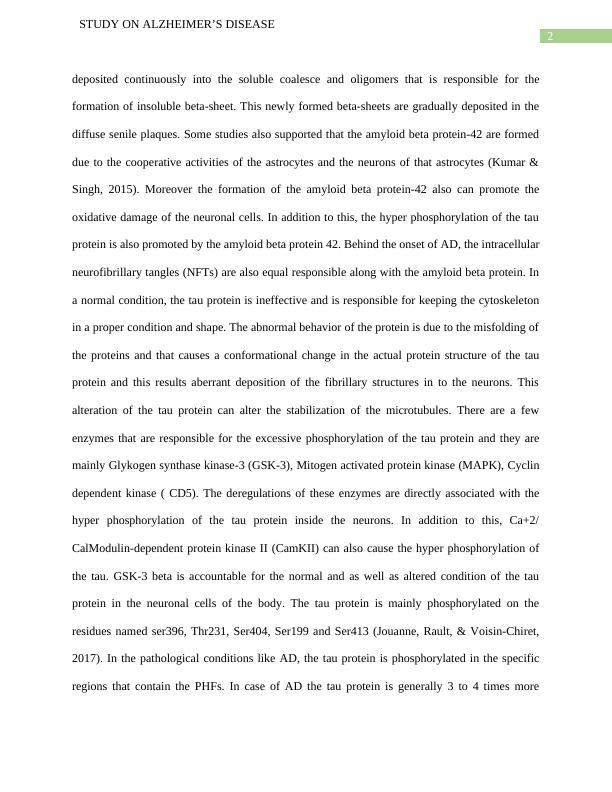Study on Alzheimer’s Disease
Added on 2023-04-21
10 Pages3369 Words272 Views
Running head: STUDY ON ALZHEIMER’S DISEASE
Study on Alzheimer’s Disease
Name of the Student
Name of the University
Author Note
Study on Alzheimer’s Disease
Name of the Student
Name of the University
Author Note

1
STUDY ON ALZHEIMER’S DISEASE
A neurodegenerative disorder refers to a huge range of condition that mainly affect the
neurons of the brain in the animal or human body. Neurons are not capable of regenerating
themselves like the normal cells. As a result, a damage in a neurons cannot be repaired, rather its
starts to degenerate gradually and at last the nerve cells or the neurons are completely destroyed.
The neurodegenerative disorders are mainly associated with the dementia problem among the
patients of neurodegenerative disorders. The most common neurodegenerative disorders are
Alzheimer’s disease (AD), Parkinson’s Disease (PD), Spinal muscular atrophy (SMA), Motor
neuron disease (MND) (JPND, 2019). In this essay, the Alzheimer’s disease, its pathophysiology
is highlighted. The drugs that can be used to treat the disease condition is also discussed.
However, AD cannot be cured but the process of gradual degeneration of the neurons can be
prevented by using specific drugs. There are a few drugs that can be used to slow down the
process of neural degeneration. The most common drugs are donepezil that is an inhibitor of
Acetyl cholinesterase, memantine that is the antagonist of NMDA receptor, galantamine can be
used as drug in treatment of AD. In this essay, the mechanism of galantamine is highlighted.
Firstly, the effectiveness on an animal model is discussed and then the usefulness of the drug on
the human body is also described in the later part of this essay.
AD is one of the most common neurodegenerative disorder. It is assumed that amyloid
precursor protein (APP) is one of the causative factors for AD. However, there are other
hypothesis that supports the pathophysiology of the AD and they are cholinergic hypothesis,
inflammation hypothesis and tau hypothesis. According to the amyloid hypothesis, the APP is
generally cleaved by the enzymes named alpha-secretase and then it is again processed by two
enzymes named gama and beta secretases. As a result the production and clearance rate of the
amyloid peptide is altered and generally clearance rate is reduced. The amyloid proteins are then
STUDY ON ALZHEIMER’S DISEASE
A neurodegenerative disorder refers to a huge range of condition that mainly affect the
neurons of the brain in the animal or human body. Neurons are not capable of regenerating
themselves like the normal cells. As a result, a damage in a neurons cannot be repaired, rather its
starts to degenerate gradually and at last the nerve cells or the neurons are completely destroyed.
The neurodegenerative disorders are mainly associated with the dementia problem among the
patients of neurodegenerative disorders. The most common neurodegenerative disorders are
Alzheimer’s disease (AD), Parkinson’s Disease (PD), Spinal muscular atrophy (SMA), Motor
neuron disease (MND) (JPND, 2019). In this essay, the Alzheimer’s disease, its pathophysiology
is highlighted. The drugs that can be used to treat the disease condition is also discussed.
However, AD cannot be cured but the process of gradual degeneration of the neurons can be
prevented by using specific drugs. There are a few drugs that can be used to slow down the
process of neural degeneration. The most common drugs are donepezil that is an inhibitor of
Acetyl cholinesterase, memantine that is the antagonist of NMDA receptor, galantamine can be
used as drug in treatment of AD. In this essay, the mechanism of galantamine is highlighted.
Firstly, the effectiveness on an animal model is discussed and then the usefulness of the drug on
the human body is also described in the later part of this essay.
AD is one of the most common neurodegenerative disorder. It is assumed that amyloid
precursor protein (APP) is one of the causative factors for AD. However, there are other
hypothesis that supports the pathophysiology of the AD and they are cholinergic hypothesis,
inflammation hypothesis and tau hypothesis. According to the amyloid hypothesis, the APP is
generally cleaved by the enzymes named alpha-secretase and then it is again processed by two
enzymes named gama and beta secretases. As a result the production and clearance rate of the
amyloid peptide is altered and generally clearance rate is reduced. The amyloid proteins are then

2
STUDY ON ALZHEIMER’S DISEASE
deposited continuously into the soluble coalesce and oligomers that is responsible for the
formation of insoluble beta-sheet. This newly formed beta-sheets are gradually deposited in the
diffuse senile plaques. Some studies also supported that the amyloid beta protein-42 are formed
due to the cooperative activities of the astrocytes and the neurons of that astrocytes (Kumar &
Singh, 2015). Moreover the formation of the amyloid beta protein-42 also can promote the
oxidative damage of the neuronal cells. In addition to this, the hyper phosphorylation of the tau
protein is also promoted by the amyloid beta protein 42. Behind the onset of AD, the intracellular
neurofibrillary tangles (NFTs) are also equal responsible along with the amyloid beta protein. In
a normal condition, the tau protein is ineffective and is responsible for keeping the cytoskeleton
in a proper condition and shape. The abnormal behavior of the protein is due to the misfolding of
the proteins and that causes a conformational change in the actual protein structure of the tau
protein and this results aberrant deposition of the fibrillary structures in to the neurons. This
alteration of the tau protein can alter the stabilization of the microtubules. There are a few
enzymes that are responsible for the excessive phosphorylation of the tau protein and they are
mainly Glykogen synthase kinase-3 (GSK-3), Mitogen activated protein kinase (MAPK), Cyclin
dependent kinase ( CD5). The deregulations of these enzymes are directly associated with the
hyper phosphorylation of the tau protein inside the neurons. In addition to this, Ca+2/
CalModulin-dependent protein kinase II (CamKII) can also cause the hyper phosphorylation of
the tau. GSK-3 beta is accountable for the normal and as well as altered condition of the tau
protein in the neuronal cells of the body. The tau protein is mainly phosphorylated on the
residues named ser396, Thr231, Ser404, Ser199 and Ser413 (Jouanne, Rault, & Voisin-Chiret,
2017). In the pathological conditions like AD, the tau protein is phosphorylated in the specific
regions that contain the PHFs. In case of AD the tau protein is generally 3 to 4 times more
STUDY ON ALZHEIMER’S DISEASE
deposited continuously into the soluble coalesce and oligomers that is responsible for the
formation of insoluble beta-sheet. This newly formed beta-sheets are gradually deposited in the
diffuse senile plaques. Some studies also supported that the amyloid beta protein-42 are formed
due to the cooperative activities of the astrocytes and the neurons of that astrocytes (Kumar &
Singh, 2015). Moreover the formation of the amyloid beta protein-42 also can promote the
oxidative damage of the neuronal cells. In addition to this, the hyper phosphorylation of the tau
protein is also promoted by the amyloid beta protein 42. Behind the onset of AD, the intracellular
neurofibrillary tangles (NFTs) are also equal responsible along with the amyloid beta protein. In
a normal condition, the tau protein is ineffective and is responsible for keeping the cytoskeleton
in a proper condition and shape. The abnormal behavior of the protein is due to the misfolding of
the proteins and that causes a conformational change in the actual protein structure of the tau
protein and this results aberrant deposition of the fibrillary structures in to the neurons. This
alteration of the tau protein can alter the stabilization of the microtubules. There are a few
enzymes that are responsible for the excessive phosphorylation of the tau protein and they are
mainly Glykogen synthase kinase-3 (GSK-3), Mitogen activated protein kinase (MAPK), Cyclin
dependent kinase ( CD5). The deregulations of these enzymes are directly associated with the
hyper phosphorylation of the tau protein inside the neurons. In addition to this, Ca+2/
CalModulin-dependent protein kinase II (CamKII) can also cause the hyper phosphorylation of
the tau. GSK-3 beta is accountable for the normal and as well as altered condition of the tau
protein in the neuronal cells of the body. The tau protein is mainly phosphorylated on the
residues named ser396, Thr231, Ser404, Ser199 and Ser413 (Jouanne, Rault, & Voisin-Chiret,
2017). In the pathological conditions like AD, the tau protein is phosphorylated in the specific
regions that contain the PHFs. In case of AD the tau protein is generally 3 to 4 times more

End of preview
Want to access all the pages? Upload your documents or become a member.
Related Documents
Treatment of Alzheimer's Diseaselg...
|5
|1181
|163
How does long term memory and short term memory differ in people with Alzheimer?lg...
|8
|2228
|45
Systematic Review in Neurosciencelg...
|19
|4643
|30
Alzheimer’s Disease | Presentationlg...
|1
|1591
|29
Care for Older People - Case Studylg...
|11
|3312
|26
Management of Alzheimer's Diseaselg...
|11
|3764
|139
